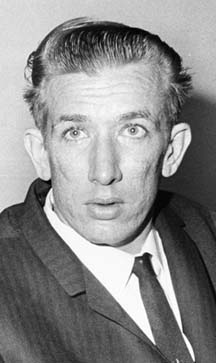Infamous 1966 Richard Speck Murders Get Mad Men Spotlight
By Chuck Sudo in News on Apr 9, 2012 3:40PM

Richard Speck in 1966
Much like John Wayne Gacy stoked the fears of Chicagoans in 1979, Richard Speck did the same in 1966 when he murdered eight nursing school students in the Jeffery Manor neighborhood on the city's South side. Born in Kirkwood, Ill and raised in Dallas with his mother and a stepfather who constantly belittled him, Speck began drinking at 13, dropped out of school at 15, and had already developed a healthy rap sheet by the time he returned to Illinois in 1966. Speck was suspected in the rape of an elderly woman and the murder of a barmaid in Monmouth, Ill. when he arrived in Chicago in April of that year and moved in with his sister and her family.
His brother-in-law, Gene Thornton, thought Speck could find gainful employment in the Merchant Marines and drove him to the U.S. Coast Guard office to obtain a letter of authority to work as an apprentice seaman, which required a physical examination, photograph and fingerprinting.
Unable to find work and having outstayed his welcome with his sister and brother-in-law, Speck raped 53-year-old Ella Mae Hooper on July 13, 1966, stealing her .22 caliber Röhm revolver in the process. Speck then spent the rest of his evening drinking in bars before heading to the townhome at 2319 E. 100th St.
He broke into the house and proceeded to systematically rape and murder Gloria Davy, Patricia Matusek, Nina Jo Schmale, Pamela Wilkening, Suzanne Farris, Mary Ann Jordan, Merlita Gargullo, and Valentina Pasion. A ninth student, Corazon Amurao, managed to escape the fate of the others by hiding underneath a bed while Speck committed his crimes. Amurao finally crawled out from under the bed at 6 a.m. and shouted, "They're all dead! All my friends are dead!" from a window. Speck's Merchant Marine employment application, in particular his fingerprints, were what led to his arrest. A local drifter, a medical student and Amurao all were able to identify Speck via a tattoo on his forearm that read "Born to Raise Hell."
Speck's jury trial began in Peoria, Ill. on April 6, 1967. Judge Emil Paschen imposed a strict gag order on media. Speck was convicted on April 15, 1967, after only 49 minutes of jury deliberation, and sentenced to death. The U.S. Supreme Court overturned the death sentence in 1971, citing their decision in the 1968 Witherspoon v. Illinois case. They found 250 potential jurors were unconstitutionally excluded from his jury because of their conscientious or religious scruples against capital punishment. Speck's conviction was returned to the Illinois Supreme Court. November 21, 1972, in Peoria, Judge Richard Fitzgerald re-sentenced Speck to eight consecutive sentences of 50 to 150 years in prison. Time magazine listed the Speck murders as one of America's Crimes of the Century in 2007.
While incarcerated in Statesville Correctional Center in Joliet, Ill., Speck continued to get in trouble. He was caught routinely with alcohol and drugs in his possession, punishment for which never stopped him. (As he said, "How am I going to get in trouble? I'm here for 1,200 years!") Speck kept two sparrows in his cell, earning the nickname "Birdman" after the Birdman of Alcatraz. He died in 1991 and his ashes were scattered to the wind after no one came to claim his body. A study of his brain found the hippocampus, which involves memory, and the amygdala, which deals with rage and other strong emotions, encroached upon each other.
Years after his death, television journalist Bill Kurtis came upon video of Speck in his later years at Statesville that showed him performing oral sex on a fellow inmate, snorting cocaine, wearing silk panties and revealing female-like breasts he supposedly developed with hormones smuggled into the prison. "If they only knew how much fun I was having, they'd turn me loose."